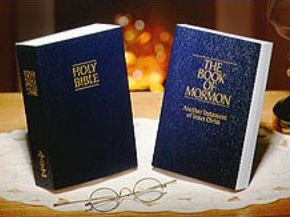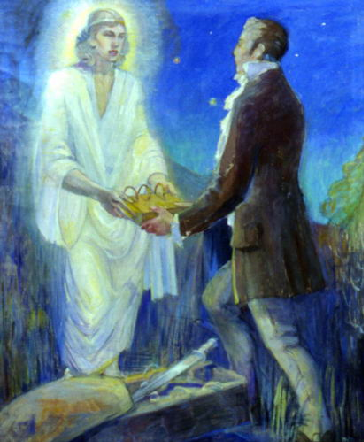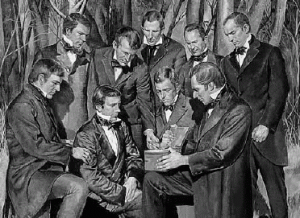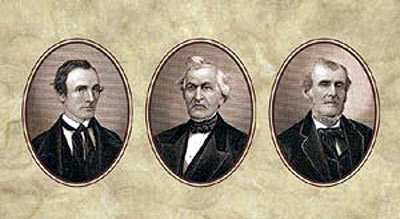Q. By the many references to the “abominable” church, is Smith referring to the Catholic Church? Furthermore, how does this square with the current tolerant approach that other religions simply don’t have the full gospel?
Thank you for this astute question. Let’s first examine these references and see what we can make of them:
The References
The clearest reference to the great and abominable church (also known as the mother of harlots and the whore of all the earth) comes from the book of 1st Nephi in the Book of Mormon. Nephi, as a prophet, is shown an incredible vision of the coming Holy One of Israel, Jesus Christ (the vision happens about 600 years before Jesus’s birth). Nephi witnesses in this vision that Jesus was born to a virgin, that he grew up to be a minister and a healer, and “that he was lifted up upon the cross and slain for the sins of the world.” The vision also shows that Jesus will visit Nephi’s own people in central America. Wonderful and welcome news.
Then the bad news comes: the righteous Nephites and Lamanites, destined to become Christians and to devote themselves to His cause, after four generations will descend into war and “shall dwindle in unbelief.” The spotlight of the vision then shifts back on the European and Middle-Eastern “nations and kingdoms of the Gentiles:”
I saw among the nations of the Gentiles the formation of a great church. And the angel said unto me, “Behold the formation of a church which is most abominable above all other churches, which slayeth the saints of God, yea, and tortureth them and bindeth them down, and yoketh them with a yoke of iron, and bringeth them down into captivity.” And it came to pass that I beheld this great and abominable church; and I saw the devil that he was the founder of it.
And I also saw gold, and silver, and silks, and scarlets, and fine-twined linen, and all manner of precious clothing; and I saw many harlots. And the angel spake unto me, saying, “Behold the gold, and the silver, and the silks, and the scarlets, and the fine-twined linen, and the precious clothing, and the harlots, are the desires of this great and abominable church. And also for the praise of the world do they destroy the saints of God, and bring them down into captivity” (1 Nephi 13:4-9).
Nephi then witnesses the merging of Old and New Worlds as the Gentiles begin to colonize the American continents. They bring with them a book that the angel describes as “a record of the Jews, which contains the covenants of the Lord, which he hath made unto the House of Israel; and … are of great worth unto the Gentiles.” That is, the Europeans are bringing the Bible to the remnants of Nephi’s people, who have dwindled in unbelief and forgotten the God they once worshiped!
This is terrific news to Nephi, but the angel isn’t finished dispensing gloom. He mentions that the Bible has been tampered with by the great and abominable church:
And the angel of the Lord said unto me, ” Thou hast beheld that the book proceeded forth from the mouth of a Jew; and when it proceeded forth from the mouth of a Jew it contained the plainness of the gospel of the Lord, of whom the twelve apostles bear record; and they bear record according to the truth which is in the Lamb of God. Wherefore, these things go forth from the Jews in purity unto the Gentiles, according to the truth which is in God.
“And after they go forth by the hand of the twelve apostles of the Lamb, from the Jews unto the Gentiles, thou seest the formation of a great and abominable church, which is most abominable above all other churches; for behold they have taken away from the gospel of the Lamb many parts which are plain and most precious; and also many covenants of the Lord have they taken away. And all this have they done that they might pervert the right ways of the Lord, that they might blind the eyes and harden the hearts of the children of men. Wherefore, thou seest that after the book hath gone forth through the hands of the great and abominable church, that there are many plain and precious things taken away from the book, which is the book of the Lamb of God [the Bible].
“And after these plain and precious things were taken away it goeth forth unto all the nations of the Gentiles; and after it goeth forth unto all the nations of the Gentiles, yea, even across the many waters which thou hast seen, with the Gentiles which have gone forth out of captivity; thou seest–because of the many plain and precious things which have been taken out of the book, which were plain unto the understanding of the children of men, according to the plainness which is in the Lamb of God–because of these things which are taken away out of the gospel of the Lamb, an exceedingly great many do stumble, yea, insomuch that Satan hath great power of them” (1 Nephi 13:24-29).
In short, Satan has success not only in obliterating the Christian religion in the New World (Nephi’s descendants), but also in corrupting the Bible of the Old World via his abominable church. This is distressing to Nephi, but he is assured by the voice of the Lord of an eventual happy ending in the restoration of the gospel, beginning with the coming forth of the Book of Mormon:
“Behold,” saith the Lamb of God, “after I have visited the remnant of the House of Israel (and this remnant of whom I speak is the seed of thy father), wherefore, after I have visited them in judgment, and smitten them by the hand of the Gentiles, and after the Gentiles do stumble exceedingly, because of the most plain and precious parts of the gospel of the Lamb which have been kept back by that abominable church, which is the mother of harlots,” saith the Lamb–“I will be merciful unto the Gentiles in that day, insomuch that I will bring forth unto them, in mine own power, much of my gospel, which shall be plain and precious,” saith the Lamb.
“For behold,” saith the Lamb, “I will manifest myself unto thy seed, that they shall write many things which I shall minister unto them, which shall be plain and precious; and after thy seed shall be destroyed, and dwindle in unbelief, and also the seed of thy brethren, behold, these things [the Book of Mormon] shall be hid up, to come forth unto the Gentiles, by the gift and power of the Lamb. And in them shall be written my gospel,” saith the Lamb, “and my rock and my salvation” (1 Nephi 13:34-36).
Nephi next sees other records come forth to restore both lost spiritural truths and confidence in the Bible. He also receives a promise that all who hearken unto the Lamb of God (Jesus Christ) will be numbered among the House of Israel and “shall be a blessed people” and “shall be no more brought down into captivity.” He sees the retribution of the abominable church:
“And that great pit, which hath been digged for them by that great and abominable church, which was founded by the devil and his children, that he might lead away the souls of men down to hell–yea, that great pit which hath been digged for the destruction of men shall be filled by those who digged it, unto their utter destruction,” saith the Lamb of God.
[…]
And it came to pass that [the angel] said unto me, “Look, and behold that great and abominable church, which is the mother of abominations, whose founder is the devil.” And he said unto me, “Behold there are save two churches only; the one is the church of the Lamb of God, and the other is the church of the devil; wherefore, whoso belongeth not to the church of the Lamb of God belongeth to that great church, which is the mother of abominations; and she is the whore of all the earth.”
And it came to pass that I looked and beheld the whore of all the earth, and she sat upon many waters; and she had dominion over all the earth, among all nations, kindreds, tongues, and people. And it came to pass that I beheld the church of the Lamb of God, and its numbers were few, because of the wickedness and abominations of the whore who sat upon many waters; nevertheless, I beheld that the church of the Lamb, who were the saints of God, were also upon all the face of the earth; and their dominions upon the face of the earth were small, because of the wickedness of the great whore whom I saw.
And it came to pass that I beheld that the great mother of abominations did gather together multitudes upon the face of all the earth, among all the nations of the Gentiles, to fight against the Lamb of God. And it came to pass that I, Nephi, beheld the power of the Lamb of God, that it descended upon the saints of the church of the Lamb, and upon the covenant people of the Lord, who were scattered upon all the face of the earth; and they were armed with righteousness and with the power of God in great glory. And it came to pass that I beheld that the wrath of God was poured out upon the great and abominable church, insomuch that there were wars and rumors of wars among all the nations and kindreds of the earth.
And as there began to be wars and rumors of wars among all the nations which belonged to the mother of abominations, the angel spake unto me, saying, “Behold, the wrath of God is upon the mother of harlots; and behold, thou seest all these things–And when the day cometh that the wrath of God is poured out upon the mother of harlots, which is the great and abominable church of all the earth, whose foundation is the devil, then at that day the work of the Father shall commence, in preparing the way for the fulfilling of his covenants, which he hath made to his people who are of the House of Israel” (1 Nephi 14:3, 9-17).
The account of the vision closes with Nephi seeing the Apostle John, where he learns that it will be John’s responsibility to “see and write the remainder of these things” including “the end of the world.” Nephi mentions that he sees many of the same things as John, but is forbidden from writing them, since they are within John’s purview alone.
As it turns out, John later wrote about the end of the world in the Bible’s Book of Revelation. He also wrote about the great whore who sits upon many waters:
And there came one of the seven angels which had the seven vials, and talked with me, saying unto me, Come hither; I will shew unto thee the judgment of the great whore that sitteth upon many waters: With whom the kings of the earth have committed fornication, and the inhabitants of the earth have been made drunk with the wine of her fornication. So he carried me away in the spirit into the wilderness: and I saw a woman sit upon a scarlet coloured beast, full of names of blasphemy, having seven heads and ten horns. And the woman was arrayed in purple and scarlet colour, and decked with gold and precious stones and pearls, having a golden cup in her hand full of abominations and filthiness of her fornication: And upon her forehead was a name written, MYSTERY, BABYLON THE GREAT, THE MOTHER OF HARLOTS AND ABOMINATIONS OF THE EARTH. And I saw the woman drunken with the blood of the saints, and with the blood of the martyrs of Jesus: and when I saw her, I wondered with great astonishment. […]
And here is the mind which hath wisdom. The seven heads are seven mountains, on which the woman sitteth. And there are seven kings: five are fallen, and one is, and the other is not yet come; and when he cometh, he must continue a short space. And the beast that was, and is not, even he is the eighth, and is of the seven, and goeth into perdition. And the ten horns which thou sawest are ten kings, which have received no kingdom as yet; but receive power as kings one hour with the beast. […]
And he saith unto me, “The waters which thou sawest, where the whore sitteth, are peoples, and multitudes, and nations, and tongues. […] And the woman which thou sawest is that great city, which reigneth over the kings of the earth” (Revelation 17:1-6,9-12,15,18).
Interpretations
That last bit from the New Testament has been interpreted by Christianity in a variety of ways. Many scholars believe that John was using veiled language in speaking about the pagan Roman empire. In particular, on contemporary Roman coins, Rome was often represented as a woman sitting on seven hills and John likely borrowed that imagery for his allusions. Some argue that it referred to a smaller group of Jewish Roman sympathizers such as the Herodians who were not well-liked by traditional Jews and early Christians.
Protestants, including Martin Luther, John Calvin, and Ellen G. White frequently attribute the mother of harlots to the Catholic church, reasoning that over the centuries this church has gained widespread influence “over many waters,” and does have a history of institutional persecution.
Nephi’s vision helps give this entity more context, at first describing it as a church which purposefully altered the Word of God (the Bible), by removing “plain and precious” truths prior to its wide distribution throughout Europe. This sounds like a specific institutional agent and is likely closely related to the earliest iterations of Christianity. Dr. Stephen E. Robinson wrote about this agent and time period in the Journal of Book of Mormon Studies:
Can we, then, identify the historical agency that acted as the great and abominable church in earliest Christianity? Such an agent would have had its origins in the second half of the first century and would have done much of its work by the middle of the second century.
This period might be called the blind spot in Christian history, for it is here that the fewest primary historical sources have been preserved. We have good sources for New Testament Christianity; then the lights go out, so to speak, and we hear the muffled sounds of a great struggle. When the lights come on again a hundred or so years later, we find that someone has rearranged all the furniture and Christianity has become something very different from what it was in the beginning. That different entity can accurately be described as hellenized Christianity (Nephi’s “Great and Abominable Church”).
Later in Nephi’s vision, the great and abominable church appears to take a more general role as any and all organized forces opposed to the Church of the Lamb of God. (“There are save two churches only; the one is the church of the Lamb of God, and the other is the church of the devil; wherefore, whoso belongeth not to the church of the Lamb of God belongeth to that great church, which is the mother of abominations; and she is the whore of all the earth.”).
This reveals a subtle shift in the way the angel frames the abominable church. At first the title is reserved for a particular entity who despicably tampers with the Holy Word; then here, it is applied to all who stand in opposition to the work of the Lord Jesus Christ. Since it appears the first abominable church (the agent that “rearranged” the Christian furniture, removing plain and precious truths from the Bible) has come, done, and gone, we take the latter interpretation for our modern guide. The LDS Guide to the Scriptures identifies the great and abominable church as “every evil and worldly organization on earth that perverts the pure and perfect gospel and fights against the Lamb of God.”
Views of other churches
Does this mean we believe Catholics are abominable? No. We only have a problem with those Catholics who pervert the gospel and fight against Jesus. That leaves a vast majority with whom we are neighbors and friends. And the same goes for Eastern Orthodox Christians, Evangelicals, Methodists, Anglicans, Copts, etc. We reach out in love to all our fellow Christians and cooperate with them in many endeavors.
There are still many beliefs that divide us (such as the common Protestant belief in Biblical inerrancy), but we don’t condemn the gentile Christians who “stumble exceedingly, because of the most plain and precious parts of the gospel of the Lamb which have been kept back by that abominable church.” We have hope in the Lord’s promise to them:
“I will be merciful unto the Gentiles in that day, insomuch that I will bring forth unto them, in mine own power, much of my gospel, which shall be plain and precious” (1 Nephi 13:34).
This promise is fulfilled whenever an ally of the Lamb (a true believing Christian) is led to discover that the gospel of Jesus Christ has been restored and that the Lord has preserved His plain and precious Word through the Book of Mormon and modern prophets. In this article I’ve already given you a taste of this rich and powerful book. Please read it and pray to God about it, that you may find the Lord’s mercy and feel His love.






